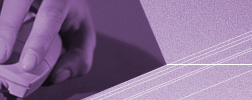 |
 |
|

|

|

|
Look for some of our educational products: 
|
 News NewsUNIVERSITY BUSINESS MARCH 2003 ISSUE FEATURES Intelligent Admission by: Tim Goral With college applications reaching record levels, IHEs are using technology to work smarter and more efficiently. College admissions have made national headlines in recent months, not only because of the debates over early decision and affirmative action, but due to the sheer numbers of prospective students applying. In top-tier schools, for example, Dartmouth College received a record 11,700 applications by its January 1 deadline, a 13 percent bump over the previous years 10,143. Yale had a total of 17,350 applications, 12.3 percent above the previous year. Harvard saw a 6.7 percent increase (20,918 applications received), and Columbia and Brown racked up 3.5 and 2.8 percent bumps respectively. "Many schools are seeing huge increases," explains Marilee Jones, dean of Admissions for the Massachusetts Institute of Technology. "Theres a new demographic of 18-year-olds; these students are more highly qualified than ever before, and more of them are applying to more schools." What this means is an increasingly difficult task for the university Admissions office, notes Jones. "In a five-year span, weve had to deal with a 33 percent increase in MIT applications," she says. "Ten years ago, we just sent materials in paper form. Now we produce paper documents in addition to electronic materials, and we have a Web presence as well. There is so much work to do to provide the same quality we did a decade ago, but weve had to do it with the same size staff in a period of shrinking funds. It has forced us to go back and figure out how to do what we do more efficiently." The challenge for schools, then, is to be able to grow their student populations without necessarily investing in more manpower. The key to that challenge? The Internet. Online Applications Applying to college online is nothing new: For some time now, prospective students could get information and download applications from many schools. But, like many Internet-age innovations, online college application has moved into the realm of outsourcing through services such as those offered by the CollegeBoard, The Princeton Review, Wired Scholar, Apply4Admissions, Xap.com, and others. These organizations sites enable college-bound students to complete forms only once. The applications can then be sent to multiple schools, eliminating a particularly tedious part of the application process. Its a popular system, but one that isnt without drawbacks for IHEs. "So far, 44 percent of our freshman applicants have applied electronically using CollegeNET, compared with 30 percent last year. Thats a 45 percent increase in a year," says Jones. "And because it relieves much of the data entry responsibilities here, the online service has really helped by allowing us to streamline the time frame in which applications are evaluated. On the other hand, we pay a percentage of each application fee to this company, so there is a loss of revenue there. Thats something we hope to bring in-house." THE HUMAN ELEMENT While the Internet has become a standard tool of the college admission operation, it isnt the be-all and end-all solution some would hope for. Admissions offices are still staffed by people whose workloads have increased because of the explosion in online admissions. For them, the question is how to work smarter, not harder. MITs Admissions office, for instance, began looking at ways to change its business processes. Four years ago, the school began a best-practice search that it could adopt to increase its efficiencies. That led to an interesting conclusion, says Dean of Admissions Marilee Jones. "We surveyed 40 different colleges and universities across the country to find out what everyone else is doing, and we realized that there is no best practice; everyone is doing something different." Now, MIT has partnered with the technology solutions consultancy Edgewater Technology (www.edgewater.com) to analyze the Admissions office business processes and workflow. "In the process of our thinking about that, weve actually come up with some great ideas about where we can streamline certain areas," says Jones. "That will mean redefining some job functions, and it will also eventually entail enhancing our Web presence so that it will be easier for students to apply, and to give us a better long-term tracking system. Well be able to better identify the hot prospects and whos been interested in us longer. That helps us triage our cases." Peter Dupre, chief technical strategist of Edgewater Technology, says that what MIT is experiencing is not uncommon among IHEs. "Most Admissions departments really havent figured out what their purposes are and who their targets are," he asserts. And, Dupre notes, technology isnt the only answer. Ideally, he says, there should be a balance between the technological and human components through the entire lifecycle of the admissions processfrom identifying prospects, engaging them through marketing, and getting them to apply, to admitting them and trying to get the greatest number of admits to enroll. "You have to determine how balanced you are in those areas. Unfortunately, what weve discovered is that most Admissions offices are tremendously unbalanced in their approach," says Dupre. To illustrate, he mentions one school he worked with that was heavily into recruitment and targeted marketing to their prospects, yet the admissions evaluation process was completely automated. That school, he says, is unbalanced because so much of its effort is devoted to the recruitment and marketing, yet when it comes to selecting the incoming class, it is left up to a machine. "MIT, by contrast, relies more on application evaluation, reading applications two or more times to identify what they call our kind of kids. But they use few state-of-the-art marketing tools to reach their prospects. The key to achieving balance is to identify which areas you need to improve, and then put in the infrastructure to support that balance."TG Customized Communication Although outsourced college application sites have served many schools well, a new generation of Web-based applications has added considerable firepower to the marketing and communications tools that a university has at its disposal. Products such as iClass from ApplyYourself, edGenuitis Student Suite, Connexxias AdmissionsGenie, and ActiveAdmissions from LiquidMatrix help the Admissions office market directly to students in ways it never could before. And, in the best style of cyber- technology, the process is automated. Whether they exist on a schools own server (compatible with all popular enterprise systems such as PeopleSoft, SCT, and Oracle) or are transparently hosted by the vendor, these modular products offer far greater control over managing the admissions process from recruitment through enrollment. Heres how they work: Prospect information is culled from various mailing lists or recruiting fairs, as well as from a students initial visit to a school Web site. Alternately, a student might recommend the site to a friend. (Sites using AdmissionsGenie, for example, even offer the chance to win school-branded merchandise in exchange for submitting names.) Then, when a prospect enters some personal information (e.g., intended study areas or extra-curricular activities) during her initial visit to a schools Web site, that data is used to "customize" the content she sees on return visits. All of the products feature the ability to send customized e-mails to prospective students automatically at scheduled times throughout the admissions process, reminding them of deadlines for forms, or providing updates of school activities in which they expressed interest. "It helps a school move from recruitment to yield," says Shawn Coyne, co-president of Connexxia. "The better informed the students, the better choices theyll make." Gerri Koch, director of Admissions for Graduate Studies at Brandeis University, says ApplyYourself, launched at the school last fall, has become crucial to the schools marketing and recruitment process. "Weve been extremely pleased with how weve been able to communicate with prospective students. We couldnt have done what weve done otherwise," she says. More Information, Better Choices Familiarizing a student with the school of his choice makes for a more successful enrollment, and the Web-based products help meet that challenge as well. ActiveAdmissions features "Admission Spotlights" that showcase faculty members and students, as well as personalized "to-do" lists and an event management tool to help prospective students schedule campus visits and interviews. AdmissionsGenie allows prospects to learn about students who share similar interests, and participate in online chats or e-mail exchanges. The "Ask a Student" feature allows prospects to pose questions to current students on topics ranging from workload requirements to the quality of cafeteria food. They can even view questions other prospects are asking, in a Frequently Asked Questions database. Saving Trees, Saving Money In addition to targeted marketing, customization, and personalized tools, the Web-based products can offer schools significant cost savings in their marketing and recruitment efforts. Typical recruitment pieces of the past consisted largely of paper productshefty full-color viewbooks, applications, letters, course catalogs, brochures, and posters. Although a significant portion of the student population still requests hard-copy recruitment materials, the Internet has allowed schools to rethink that aspect of their marketing campaigns, for substantial savings. "Not long ago, the average Admissions office might send out 50,000 or more copies of its viewbook," notes Len Metheney, president of ApplyYourself. "At $3 to $5 printing cost per book, and $2 or $3 postage, it was not uncommon for a large Admissions office to have half a million dollars or more invested annually in the production, printing, and mailing of these viewbooks alone." Koch at Brandeis agrees that the ApplyYourself system helped the school realize significant cost savings. "Because we can send sophisticated HTML marketing pieces, weve done away with almost all of our direct mail pieces," Koch says. "Weve been able to become far more efficient and effective all around." AdmissionsGenie offers a feature that enables students to request high-quality customized brochures and posters, based on their stated interests. The print-on-demand system, sub-contracted and managed by Connexxia, adds an effective targeted marketing tool at a fraction of the cost of full-run printed pieces. When a student requests a poster from the schools Web site, it will feature student-specific information and graphics printed on a predesigned template. For another student requesting a poster, the layout will be similar, but the content will be geared to her interests. Although the surge in the number of online applications coming in to the Admissions offices has increased workloads for many of the personnel there, these streamlined, automated Web solutions have helped some schools reduce processing costs. Using the ActiveAdmissions package, the University of Dayton, for example, reduced its per-application processing cost by 20 percent over four years. The schools online applications rose by 50 percent in that same period. Database Tools Who Does What? Use this quick guide to begin your search for admissions technology vendors Outsourced Application Processors Apply4Admissions www.apply4admissions.com CollegeBoard www.collegeboard.com CollegeNET www.collegenet.com FACTS (for Florida students) www.facts.org Texas Common Application (for Texas schools) www.applytexas.org The Princeton Review www.princetonreview.com Wired Scholar www.wiredscholar.com Xap.com www.xap.com Web-based Recruitment/ Application Products Company: ApplyYourself Product: iClass www.applyyourself.com Company: Connexxia Product: AdmissionsGenie www.admissionsgenie.com Company: edGenuiti Product: Student Suite www.edgenuiti.com Company: LiquidMatrix Product: ActiveAdmissions www.liquidmatrix.com As anyone who has managed a direct marketing campaign knows, a marketing effort is only as effective as its database is clean and well constructed. Following the rule of "garbage in, garbage out," if the information in a database is faulty, the school will lose money by sending materials to wrong addresses or duplicate names. John Meagle, president of edGenuitis North American operations, says the companys Student Suite address-point verification system instantly checks the information a user enters on a Web form. "We overlay postal and census information to verify that a building exists at the address that a user lists," Meagle says. "We can even tell whether a building is an apartment or a condo, and prompt the user for that extra piece of information to make sure they get the data they request. It virtually eliminates bad addresses and return mail. In this marketplace, that can result in significant savings." Whats more, in this age of SEVIS, Student Suite scans FBI and Interpol databases to check that a prospective students name is not among those of known terrorists. Evaluating Results Connexxias Coyne tells of one university that raised a concern about the effectiveness of the AdmissionsGenie customized marketing programs among various demographic groups. "They were sensitive to the conventional wisdom that said white students would use the system more than minorities, or that men would use it more than women," he says. "In fact, we found that white and non-white students visited the site with exactly the same frequency over the evaluation period. Men and women also visited the site in almost equal numbers." After the system was in use, this same university uncovered another benefit: a greater yield of top SAT scorersmany of whom were typically lost to other universities. The school also noted a slight decline in applications from students with SAT scores at the low end of the schools suggested range. Because of the targeted marketing and self-defining tools embedded in the universitys new online admissions process, those students could determine early on that the school wasnt the best fit for them. Still, with any new admissions system, its a good idea to continually gauge the effectiveness of the marketing tools. "You can put new systems in place, but you have to check and double-check to confirm that you are on the right path," says Koch at Brandeis. "We had a list of e-mail addresses for more than 18,000 people who had expressed an interest in pursuing an MBA. After sending e-mails to this group, we tracked nearly 700 click-throughs to our Web site from prospects who were completely unfamiliar with us before." At the completion of the MBA admissions process, Brandeis sent a survey to its newly enrolled students to find out how effective they found the system. Besides being "blown away" by the positive responses, Koch says, the exercise showed how Brandeis might tweak the program in the future. For example, the school could probably cut back slightly on the number of e-mails sent to students and still be as successful. "As time goes on and we learn a little more about the Web marketing process, we can plan better and stagger the e-mails and marketing pieces we send a little more effectively," says Koch. "The students are our audience, and its all about what they tell us works for them. Its all about serving the customer, and if it makes us more efficient and saves us money, thats value added." |











